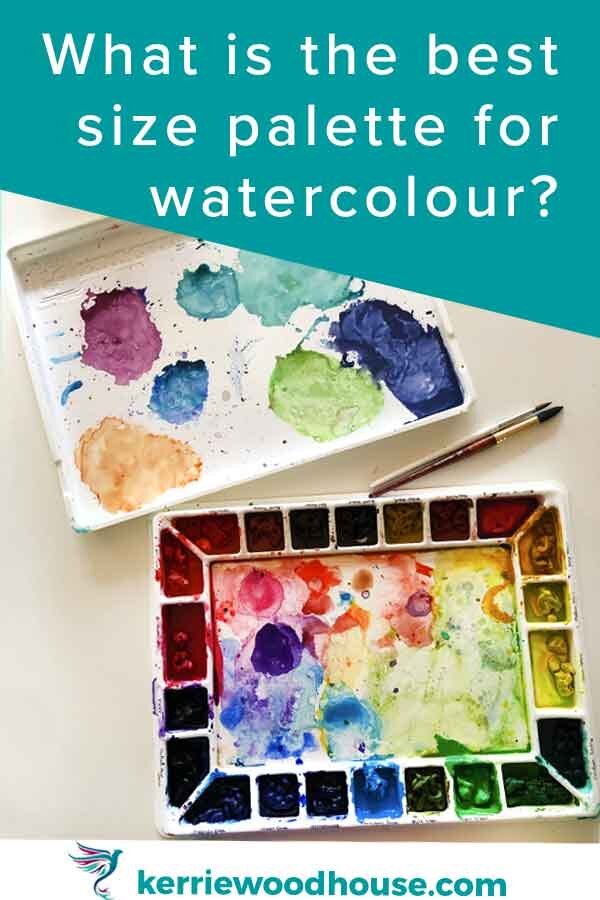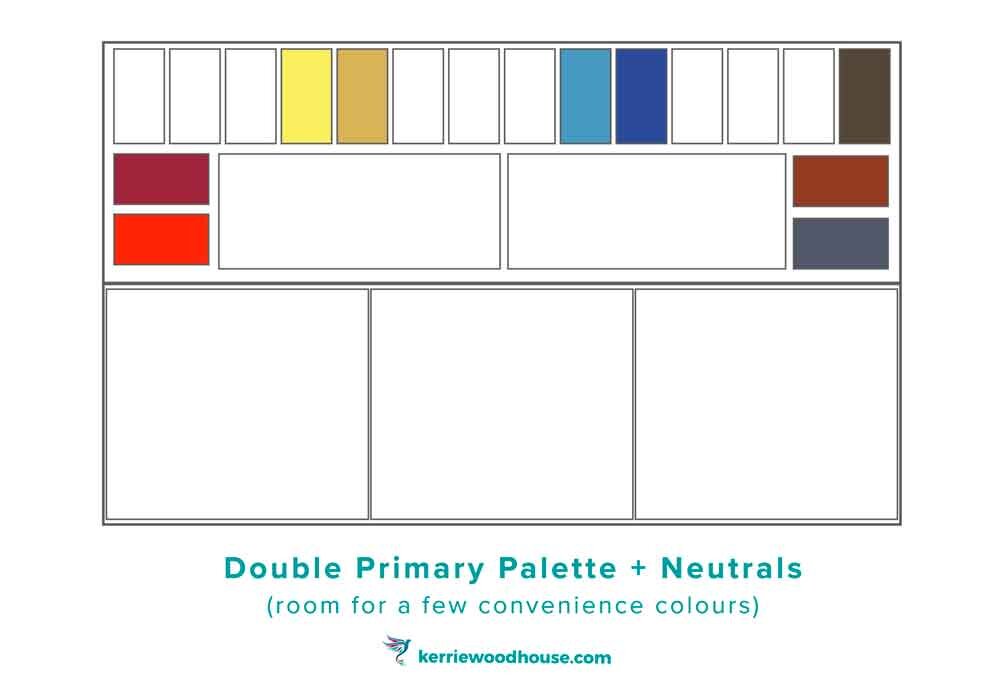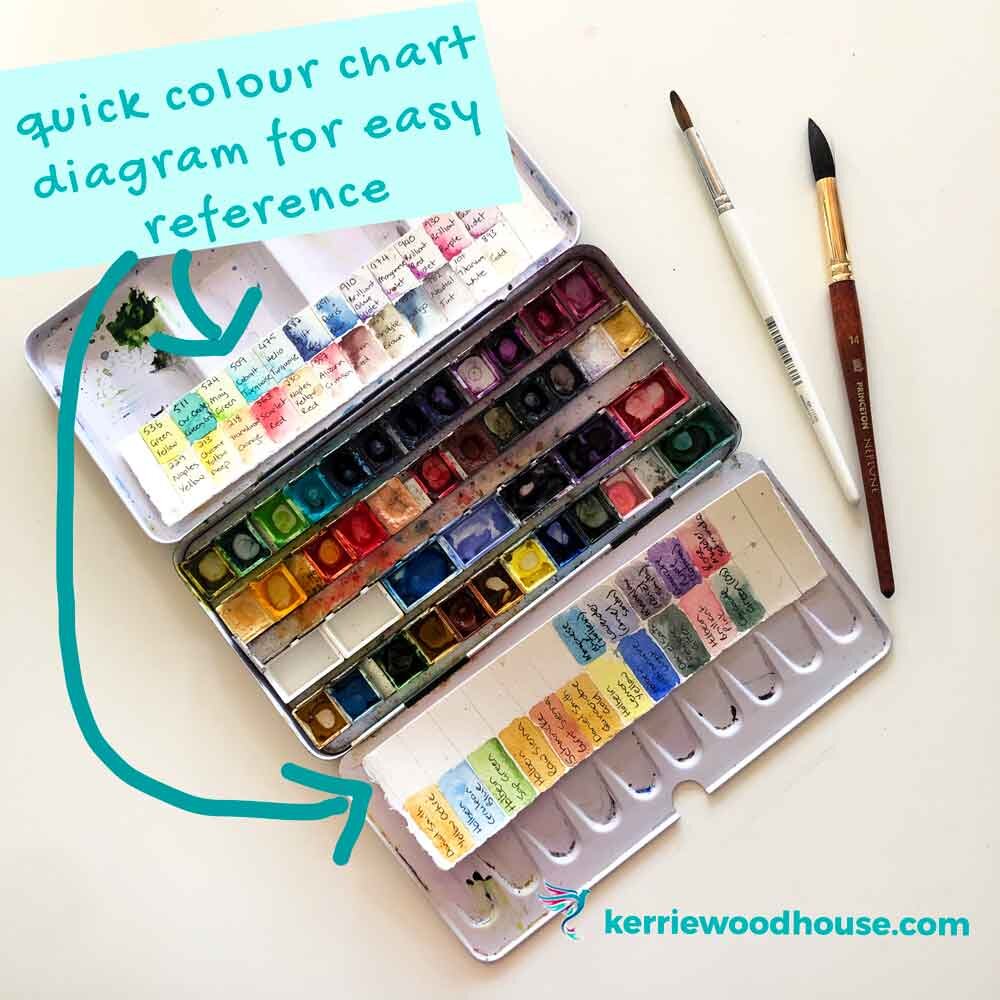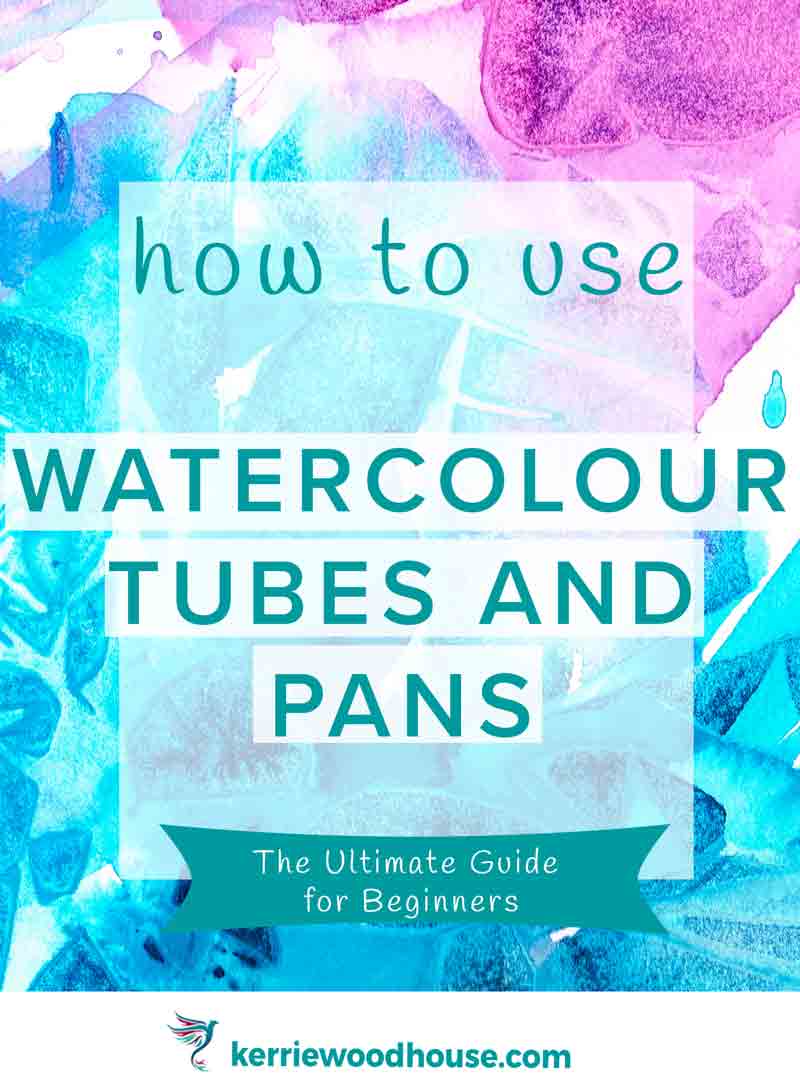Disclosure: This post may contain affiliate links. That means if you buy something we may possibly get a small commission at no extra cost to you.
If you are new to watercolour and looking at setting up your paints and palette you may have already discovered so many types of palette available that it makes for a daunting choice!
Let’s break it down and make it simple, shall we?
Here are my thoughts on each of the types of palette available for your watercolours and my advice on how to set up your palette.
Prefer a video tour of watercolour palette options? That’s next, but the written version is below the video if you would rather read.
Simple Flat Watercolour Palettes
When I first began my watercolour journey (many years ago…) I heard that it was best to squeeze your paint fresh from the tube before each painting. More on that idea in a minute, but first let’s see the options for the very simplest of palettes.
a cheap plastic palette with little wells and mixing spaces that you can find in any art supply store
a ceramic dinner plate - preferably unpatterned and I would suggest white
a paper plate
pads of palette paper
a scrap of watercolour paper
Basically anything that can take a bit of water will do, since water is all that is required for watercolour paints. No need to rush out and buy a palette if you don’t want to - you are sure to be able to find something around the house that will work for you.
I am happy to report that, in my experience, using paint that had previously dried on my palette was really no different from freshly squeezed paint. I am totally addicted to colour and I have never been disappointed with the results from my dry pans of paint.
I also believe that if you do use watercolour straight from the tube every time you are missing out on one of the most appealing things watercolour has to offer - convenience.
While I love watercolour, I also find oils rather wonderful. However, I paint with oils so infrequently because it is a right palaver to set it all up and squeeze out all the colours - invariably in the wrong amounts.
Too much and you feel terribly extravagant and wasteful at the end of the painting session. 😱
Too little and you end up interrupting the whole flow of painting to get out more paint. 😕
Not to mention that it is rather a mess to clean up and put away.
Watercolour requires only that I flip open my paintbox and give it a little spritz with water. Clean up is as simple as shutting the paintbox. What’s not to love?
My little watercolour palette box makes my life so much easier.
So my first suggestion is to find a paint box with a lid. Again - there are quite a few to choose from!
Prefilled Watercolour Paintboxes
Of course you can often buy the paint box prefilled with a range of watercolours. Marvellous. There is usually also a mixing area in the lid, or sometimes in little pull out trays.
As convenient as this is, you may want a little more control over the choice of colours and opt to buy an empty palette box and fill it yourself.
Empty Watercolour Palette Boxes with Lids
My first lidded palette box was this one which is rather large. Big wells and plenty of mixing space have the spirit of abundance about them and I do love that.
Another advantage of these generous wells for the paint is that they are a little kinder to your brushes. I use large brushes and I know that in the smaller wells of my current paintbox I am often pushing the brush against the sides of the wells and therefore may be doing them some damage over time. The large wells can take the whole brush so that happens a bit less.
However, I have found that the large size is just a little unwieldy.
Being so big makes it tougher to store and I just don’t seem to use it as much because I need to have a bigger space to paint in. It seems silly, but I think these practical considerations are what make the difference between actually painting and just intending to paint.
Personally I’m okay with knowing that I might have to replace my brushes a little more often because I choose the easy life with more painting and less fuss.
Fixed Watercolour Pans or Loose Pans
You can get inexpensive palettes and palette boxes that are made from moulded plastic. That means the paint wells are fixed and cannot be moved around.
There are also palettes that are usually metal and take little loose plastic pans. The pans clip into the palette so they don't wobble about but you can move them if you want to. You can buy the little pans filled or you can buy them empty and fill them yourself from tubes. I do both.
You can find out more about the question of watercolour tubes vs pans from this ultimate guide for beginners.
How to Set up the Colours in your Watercolour Palette
One of my lovely students asked me about the best way to set up her new watercolour palette. She had just purchased a double primary tube set and an 18 well palette.
The double primary is a very common selection of colours that you might come across in the art store. All it means is that there is a pair of each of the primary colours, red, yellow and blue. Giving you a warm and a cool version of each of the colours gives you more options when it comes to mixing any other colours you might need.
When I was asked this question it did make me realise that I am not particularly organised with my palette and I don’t do much colour mixing on the palette either.
Eventually each of us finds what works best for us and there really isn’t any right or wrong way to go about it. But that is not much help when you are faced with a clean new palette and some fat tubes of paint, now is it?
So here is what I suggest.
Arranging the Colours in your Watercolour Palette
If your palette has fixed wells rather than the little empty pans that can move around you probably want to leave yourself room for collecting new colours in the future. (So Much Fun)
Let’s say you have 6 colours and 18 spaces in your brand new palette.
A nice simple way to go about it would be to put in the
2 reds, then leave 4 spaces
2 yellows then leave 4 spaces
2 blues, then you should have 4 spaces left.
That way you can have your colours arranged in the colour wheel. If you decide to get a green later on you could put it in between the yellows and blues, an orange would go in between the reds and yellows etc.
Of course, the system is never going to be perfect because you might have something like a brown later on and then you have to figure out where that goes. I would pop it in next to the reds if it was a warmer reddish brown or the blues if it was a cooler brown.
An alternative would be to leave only 3 spaces between the primary pairs and then you would have an extra section to put in the browns or maybe a paynes grey or whatever you might end up with in the future.
The other thing that often happens is that you find yourself collecting more of one set of colours than another. For example, if you decide you like painting florals and you start buying more pinks and reds you might end up having to put a red in the blue section because you ran out of empty wells.
If that sort of thing is going to bother you, I would definitely consider buying a palette with loose pans that you can move around.
I must say that although I can move the pans around in my palette I never seem to do that much. You do get used to where your colours are in the palette quite quickly and I think that adds to the ease and convenience of painting. It’s just like the way you grab the wooden spoon and the mixing bowl without really thinking about when you are baking - imagine someone rearranging your cupboards before you baked! It’s the same with painting.
A Final Tip to Make your Life Easier
One thing I would recommend (and it's quite fun to do) is to draw out a little diagram of your palette on watercolour paper and then write the name of your colour in a waterproof pen on the square. Then you paint a little swatch of the colour onto the appropriate square. That way you have a little reference of what each colour looks like on the paper, and you know which tube to use to fill it up when you need to.
These are mine.
I don’t have a lot of patience for swatching colours but I know many people love doing that. Mine are just little strips of paper that fit in the box, but of course you could draw out your palette in a neat realistic diagram and make a whole creative project out of it. Do what makes you happy!
I find this very useful because I have a few dark blues and purples that look very similar dry in the palette (see what I mean from the photo above) so without my handy reference I would never know which one to use.
It's nice if you can cut the palette swatch chart you make into a size that can fit into your palette (if it has a lid). Or you can just keep it handy with all your painting supplies.
By the way, if you have more questions about watercolour supplies, I have a whole class on that.
It’s free to all my subscribers, and you can sign up below.
The Beginner’s Guide to Watercolour Supplies
Are you on your own painting journey?
One of these might be useful…













